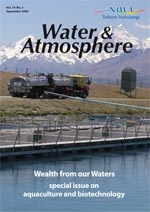PDF of this article (55 KB)

One of NIWA’s aims with this magazine is to contribute to science education in New Zealand. To this end we distribute Water & Atmosphere without charge to New Zealand high schools. Articles are assigned ‘Curriculum Connections’ to indicate which of the NZ NCEA Achievement or Unit Standards they can complement as a classroom resource. These links are assigned by Royal Society of New Zealand Teacher Fellows who are working during the year with NIWA scientists.
Remember that there is an Archive of past issues beginning with September 2000 (vol. 8, no. 3). All online articles include a pdf of the printed version and the articles are indexed via the website’s search engine.
Curriculum connections for this issue
| Article | Relevant NCEA Achievement and Unit Standards | Brief summary |
|---|---|---|
| New aquaculture species: adding real value to New Zealand seafood | Biology 90461 (2.5), 90769 (2.2), Level 2 US6309, Level 1 US6299 Geography 90204 (1.3) Science 90187 (1.2), Level 3 US8153, US21613 | NIWA’s experience solving the problems of culturing kingfish can help lead the way to raising the value of New Zealand aquaculture. |
| Creating the right conditions for paua | Biology 90716 (3.4), 90769 (2.2), Level 3 US8933, Level 2 US6309, Level 1 US6299 Geography 90204 (1.3) Science 90187 (1.2), Level 3 US21613 | NIWA has developed a system of farming paua that produces higher growth rates than conventional systems. |
| Anti-cancer sponge: the race is on for aquaculture supply | Biology 90718 (3.6), 90769 (2.2), 90162 (1.2), Level 2 US 6310, Level 1 US18978, US6299 Geography 90204 (1.3) Science Level 3 US21613 | A native New Zealand sponge is the source of peloruside A, a chemical compound that is being tested as a cancer treatment. |
| GreenshellTM mussels: the case of the disappearing mussel spat | Biology 90716 (3.4), 90461 (2.5), 90769 (2.2), Level 3 US8933, US21613, Level 2 US6312, US6309, Level 1 US6299 Geography 90204 (1.3) Science 90187 (1.2) | NIWA research has solved many of the problems of culturing mussels, including how to quickly check the health of spat. |
| New drugs from nature: the TerraMarine partnership | Biology 90718 (3.6), 90769 (2.2), 90162 (1.2), 90168 (1.8), Level 3 US6320, Level 2 US6310, Level 1 US18978, US6298 | A research consortium is screening thousands of New Zealand organisms in search of natural anti-inflammatories. |
| Developing natural solutions for a ‘foul’ problem | Biology 90718 (3.6), 90769 (2.2), 90168 (1.8), Level 3 US6355, Level 2 US6310, US6298, Level 1 US18978 Science Level 2 US6352 | Natural antifouling chemicals produced by marine plants and animals are going into commercial paints and plastics. |
| A surprising use of fish waste | Biology 90718 (3.6), 90769 (2.2), 90162 (1.2), Level 3 US6320, Level 2 US6310, Level 1 US18978 | NIWA is testing fishery byproducts in search of bioactive compounds that can be used, for example, for UV protection in skincare products. |
| Tapping into the power of marine bacteria | Biology 90718 (3.6) 90769 (2.2), 90168 (1.8), 90162 (1.2), Level 3 US6320, Level 2 US6310, Level 1 US6298, US18978 Science 90188 (1.3) | We’ve collected thousands of marine bacteria and tested hundreds in our search for new uses ranging from antibiotics to omega-3 oils. |
